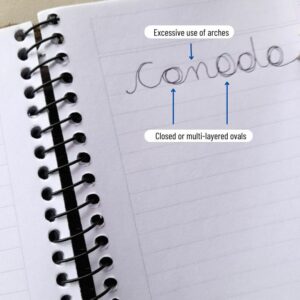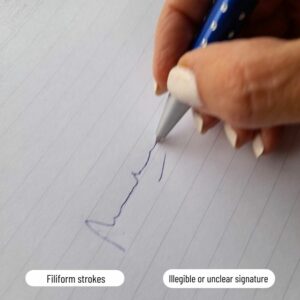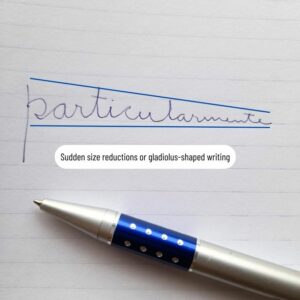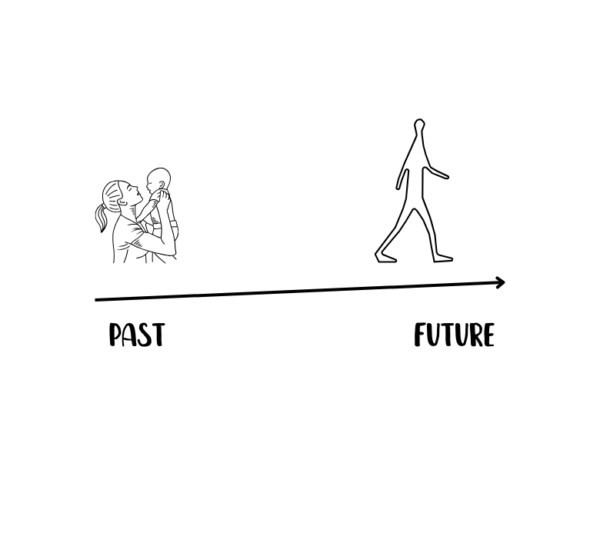Graphology and Lies: Detecting dishonesty in handwriting
Hello friends! Today, I invite you to delve into the realm of lies and dishonesty within handwriting. Detecting lack of authenticity in handwriting isn’t a straightforward task, but it’s achievable.
In this article, we will plunge into the intriguing world of graphology to uncover how strokes can reveal hidden secrets. Specifically, we will explore how graphology becomes a revealing tool, unraveling the mysteries of lies and dishonesty concealed within each handwritten script.
Being honest means behaving and communicating sincerely and ethically. It involves telling the truth, being consistent between words and actions, being transparent, and taking responsibility for the consequences. It’s not just about being honest with others but also about being honest with yourself.
Graphology unmasks the lie: Levels of dishonesty through Handwriting Analysis
Honesty is one of the most sought-after skills when hiring for a job or in personal connections. It represents a fundamental value in people, work teams and organizations, directly impacting productivity at both an individual and collective level. It involves acknowledging mistakes, seeking help when necessary, and collaborating as a team without claiming individual achievements. Honest people establish strong ties with the company, are trustworthy with sensitive information, and avoid actions that could be harmful. This value, ingrained in all employees, facilitates the construction of strong and productive teams.
Handwriting Analysis and Deceit
Revealing secrets: graphology reveals levels of dishonesty and lies in handwriting
Dishonesty and lies, like many things, exist on a spectrum. Let’s go from the least intense to the most serious. Telling lies can happen without bad intentions, like when someone asks you if you like her new car and you say it without being completely honest. This represents the mildest form of lying. Then there is the compulsive liar. Let’s delve into this topic.
People who lie seek to hide or disguise who they really are. They avoid revealing their true essence. But you can feel its energy and gain a deep understanding of those around you.
Beyond Words: The Depth of Dishonesty revealed in Handwritten Script
Tell apart the social liar from the pathological liar. Unveiling the Motivations Behind Lies: Handwriting Insights into Natural and Pathological Liars Handwriting.
It’s interesting to discover why those who lie, lie.
The Natural-Social Liar
The most common liar is the natural-social liar who lies to feel more comfortable in social settings. They may falsify or exaggerate their achievements or experiences to impress others or maintain a positive image. Alternatively, they might downplay problems or difficulties to prevent others from worrying about them. Their intention is not to cause harm or deceive maliciously but to use lying as a strategy to maintain superficial harmony in their social relationships.
There are indicators in handwriting (excessive loops in certain letters, exaggerated uppercase letters, larger handwriting) that suggest a lack of spontaneity in communication. On the other hand, when lying is by omission or out of cowardice, it is accompanied by signs of weakness, such as weak pressure, small handwriting, a signature to the left of the text, or a small signature wrapped within the rubric.
The Pathological Liar
The pathological liar describes someone with a persistent and compulsive tendency to lie constantly without an apparent motive or clear logic. The inclination towards compulsive lying generally constitutes a central element of their personality and behavior.
Pathological liars may invent entirely fictional stories or significantly exaggerate facts. The motives behind a pathological liar’s behavior are usually complex mechanisms. They include psychological factors such as the pursuit of attention, the desire to feel important, or the personal satisfaction they derive from deceiving others. They often lie simply out of habit and may be related to disorders such as antisocial personality disorder (also known as sociopathic personality disorder) or narcissistic personality disorder. These disorders are associated with a lack of empathy, impulsivity, and a tendency to manipulate others.
Dishonesty Indicators: Graphological Signs of Dishonesty
In handwriting, signs of artificiality and excessive embellishments can be found, such as inflated upper zones (indicating an exaggerated sense of morality) and inflated lower zones (indicating exaggerated desires). Slow handwriting may indicate potential culprits attempting to disguise and conceal; someone who lies frequently and calculatedly.
Here are the significant traits to analyze. You’ll find each of them with images and examples as indicated in each case.
Decoding Deception: Graphology’s Exploration of Dishonesty Levels in Handwriting
It’s impossible to fully guarantee a person’s reliability. Always remember that if a sample contains one or two of these traits, it doesn’t necessarily mean that the person is dishonest. These indicators should be considered along with the rest of the aspects. Despite the lack of absolute certainty, graphology is a tool that reveals signs enabling the identification of the power of honesty and multiple indications of falsehood.
Main Signs of dishonesty in handwriting
The main signs that constitute the general negative level are:
- Confused writing: Disorder, confusion, illegibility, inequalities in spacing and movement. Certain letters or parts of letters invade the space in the lines above or below.
- Disproportions and inequalities in dimension, pressure, direction of lines or parts of letters. Artificial writing of unique shapes: Can be interpreted from snobbery and exhibitionism to concealment and dissimulation.
- Regressive movements, sinuous lines, ring-shaped ovals, bottom-closed ovals, filiform writing. Regressions, inverted inclination: Read also: Slant of writing.
It is important to remember that these traits are not definitive evidence of a person’s dishonesty. However, some traits that have been associated with dishonesty in handwriting are as follows:
General traits of dishonesty in handwriting:
- Illegible handwriting will indicate a lack of transparency and sincerity, the need to intrigue or generate doubts, and a lack of moral sense that leads to evading responsibilities. Illegibility due to letter deformation will mark the hiding of the true personality with the intention to conceal or cover up, which can be caused by feelings of guilt, lack of adaptation, or insecurity.
- Ovals with double closure or closure from below following the clock hands in adults: Excessive reserve, concealment. Closed or multi-layered ovals that are excessively closed or have multiple strokes may suggest a desire to conceal information or a reserved attitude. See graphology of the letter “a” the letter of sincerity.
- Thread-like writing: Diplomacy, dissimulation, concealment. Filiform writing will indicate an evasive self. The tendency to surround things with an aura of mystery. Opportunistic intelligence. The need to intrigue or create doubt. The lack of moral sense that leads to avoiding responsibilities. The tendency to not always tell the truth. It will reflect insincerity, lies, ambiguity, and simulated adaptation. It will be a sign of questionable trust and adaptation according to circumstances, also pointing to an individual who skillfully can penetrate and grasp the needs of others and deceive them, commonly found in scammers and forgers. It will also indicate a tendency to evade responsibilities. Intentional filiform endings within the context of slow handwriting will indicate cunning, evasion, and lies, where the inclination towards fraud, hypocrisy, disguise, and deception will be a permanent mode of operation. It will denote an individual who promises things they know they won’t grant or fulfill.
- Sinuous or serpentine writing/lines or words: Writing that exhibits exaggerated curves or undulations may reflect a tendency to hide information, lie, be cunning, false, or hypocritical. Lack of moral firmness, versatility, impressionability.
- Tracings of artificial or very regular shapes. Large inflations, mainly curved: Mythomania, desire to grab attention. It should be corroborated if it appears in humps or in descenders.
- Excessive use of arches: Excessive arched writing will indicate a tendency towards concealment, hiding, and simulation, reflecting the concealment of true personality and insincerity. Here, the predisposition to lies and skillful management of appearances play an important role in deceit, fraud, or scams. Hypocritical kindness, concealment, simulation, selfishness, and cynicism will be other characteristics of this sign. It also indicates a predisposition towards appropriation and hoarding. Accentuated arches towards the end of words. The arch is a regressive movement: Ability to feign or disguise.
- Exaggerations, especially in capital letters.
- Sudden decreases in size. Last letters of the word illegible or replaced by a dash. Size reductions or gladiolus-shaped writing: They may indicate skills for persuading, convincing, deceiving, and pretending. Variable size of letters within the same word: See dimension.
- Illegible or unclear signature: A signature that cannot be read or is unclear can be interpreted as a lack of transparency or an intention to conceal one’s true identity. Read in Signature.
- Negative differences between signature and text: When there is an evident contradiction between the writing style of the text and the signature, it may suggest a lack of integrity or an intention to deceive. It is necessary to rule out professions in which the individual must sign many documents per day or cases of doctors who, due to tradition or haste, use filiform strokes or illegible signatures. These differences arise between the signature and the text, it indicates conflicts in personality, dissociation of behavior, discordance between desires and decisions. Continue reading in the section: The SIGNATURE in Graphology.
Decoding Deception: Graphology’s Exploration of dishonesty Levels in Handwriting
It’s impossible to fully guarantee a person’s reliability. Always remember that if a sample contains one or two of these traits, it doesn’t necessarily mean that the person is dishonest. These indicators should be considered along with the rest of the aspects. Despite the lack of absolute certainty, graphology is a tool that reveals signs enabling the identification of the power of honesty and multiple indications of falsehood.
It is important to bear in mind that these traits are only indicative and should not be used as conclusive proof of a person’s dishonesty. They should be compared with other tests and assessments.








